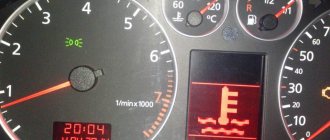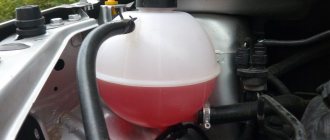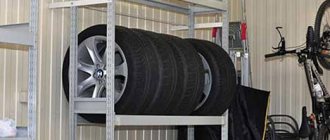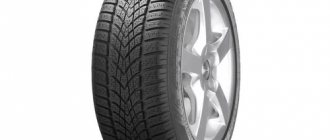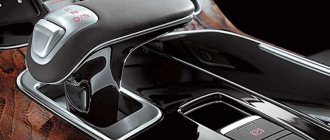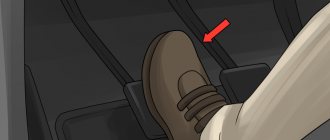A car needs not only changing winter tires or engine oil, but also refueling with gasoline. Antifreeze needs to be updated regularly. Or not? In fact, it all depends on the type of vehicle and the fluid used.
Let's find out the real expiration date of antifreeze. It depends on the tightness of the packaging, storage conditions, color of the liquid and a number of other factors. Let's take a closer look at all these points.
Antifreeze g red expiration date
It is not entirely correct to say that it was one color or another.
There are only a couple of factories in Europe that brew similar liquids, so both VAG and Phoebe are bottled from the same tap, but at the same time different color additives are added to the same base. -if the owner of an older Passat or Golf at a premium decides to buy antifreeze from an official dealer, then he will be offered not G11, which is required by VIN, but its modern replacement. However, you can find anything in retail.
-there is such a wonderful joke: a father and a kindergarten-age son are walking.
The son bites an apple, looks at it, and asks his father: - dad, why is the apple darkening? - you understand, son, the apple contains iron elements, which oxidize when they come into contact with oxygen atoms, and you are now observing the result of this chemical reaction -... dad , and who were you talking to just now? - so as not to move into this area, I will not delve into the chemical composition of antifreeze, write its formulas and other rubbish.
Shelf life of antifreeze, rules for storing coolant
So, for example, many foreign antifreezes compare favorably with domestic types in both quality and shelf life. Many novice car enthusiasts are interested in the question, what is “Antifreeze”?
This is a traditional type of coolant that was manufactured in our country during the Soviet era. It was the only refrigerant of its kind, so this name is often used in a negative sense. Today, this coolant is produced in Ukraine and Belarus. The danger of purchasing Russian coolants is the possibility of purchasing counterfeit ones.
Naturally, the shelf life of such a surrogate is reduced significantly compared to antifreeze from Europe or Japan. Domestic manufacturers began to add additives to Tosol in order to significantly reduce the formation of corrosion in the cooling system. This method was borrowed from foreign brands, which led to improvements in the smooth operation of propulsion systems, as well as:
maxx096 › Blog › Selecting antifreeze by color
To change antifreeze, it is better to completely replace the cooler in accordance with the time specified by the manufacturer. The main difference in color between G12 antifreeze and G11G12 is that it is red-painted, or less often yellow-colored, carboxylate antifreeze.
It is characterized by a local effect, that is, if a corrosion lesion has formed in the system, then the additives localize it.
This allows the antifreeze to work with sufficient efficiency for a considerable period - from 5 years, and only then its additives are depleted. G11 is a silicate antifreeze.
It interacts with all surfaces of the system, covering all parts with a protective film. Therefore, its service life is shorter - up to three years. When first using one of these types of antifreeze, and then changing it to another, one nuance should be taken into account.
Antifreeze G12 - a product that extends the life of a car
As practice shows, G12 is an antifreeze that has an anti-corrosion and carboxylic acid composition of organic origin.
For the motorist, this means that this coolant already contains very good detergents, so when replacing it after the end of its useful life, there will be no need to flush the system. The anti-corrosion additives that G12 Plus Plus antifreeze contains do not clog the cooling system.
They are attracted only to those places where corrosion is actively localized, and are distributed over all undamaged areas by the thinnest protective film, not exceeding 0.1 mK in thickness.
It is poured into the system directly on the production line.
Free legal consultation: For any questions
Submission to the authorities.
Tracking. Control of every movement of the case. There is always a possibility that the client does not need to go to court or draw up a claim and other documents, since there is no prospect of winning and the client will waste time and money, or worse, worsen his situation.
This is why our company’s lawyers first do a free analysis of the situation, study the available documents, and only after that offer solutions, if any.
Why do they trust us? Quality of service For more than 10 years, our company has been providing free legal advice in various areas of civil law. Speed Professionals in their field will advise you within 5 minutes.
And you will know everything about solving your situation. Knowledge Each client's case is transferred to the appropriate legal department, where it is analyzed by at least 3 specialists, including a senior lawyer. Confidentiality In accordance with the Federal Law of the Russian Federation of July 27, 2006 N 152 “On Personal Data”, we guarantee complete confidentiality of all consultations. Savings Thanks to our extensive experience in the field of civil law, we can confidently say what to do in various situations.
Minimum actions for maximum results. Ease When contacting us, clients forget about their problem.
Entrust your care to us, professionals in our field.
Get a free consultation right now! Moscow St. Petersburg By clicking the SEND button, you accept the terms Send Send Our lawyers and attorneys will help you “Every problem can be solved through the means of the law.
Substitution rules
When replacing consumables, adhere to the following rules:
When changing the fluid, be sure to flush the cooling system. To do this, you can use special products that are poured into the expansion tank. When using such substances in a car, you should drive from 20 to 200 km, depending on the recommendations indicated on the packaging. Rinsing can be done with distilled water, Coca-Cola, water with the addition of vinegar or citric acid. When filling, do not use concentrated liquid. It is better to dilute such a refrigerant with distillate; the proportions for this are indicated on the packaging. After filling the refrigerant, do not add water to the cooling system. Mixing with other brands of antifreeze, especially those of different standards, is not recommended
If it is necessary to add, it is important to ensure that the compositions of the substances match. If the refrigerant is not recommended for your vehicle, it is best to avoid using it.
How to change antifreeze
Changing antifreeze begins with draining the old one. This is not always easy, for example, look on the Internet for a video of the process on a Scania truck, where truckers are trying to fix problems on the spot.
On a cold engine, remove the tank or radiator cap, insert an unnecessary container, and unscrew the drain plug. The liquid should be completely drained and the system should be cleaned several times (fill with water, turn on the engine for 10 minutes). To obtain the desired effect, it is better to add 20% antifreeze (10% concentrate) or a special substance to the water.
The car is turned off and the cooled mixture is removed. The last time is washed with water, do not turn off the car for 15 minutes, let it cool and drain again. To remove air, turn on the heating and the engine itself for about 10 minutes. Then add the mixture to the normal level, checking the amount after a few days.
How long to store antifreeze
All components of a car have a certain period of useful use, and coolant is no exception. However, not all drivers know the expiration date of antifreeze and how often it should be changed. Let's try to understand this issue, because the operation of the engine depends on the proper state of the substance
and the overall functioning of the machine.
Purpose of coolant
This name is given to a special automotive coolant, the use of which is due to the fact that its freezing point is significantly lower than that of water. In addition, its expansion coefficient in a cooled state is much less.
It is these properties that help the driver protect his vehicle from unwanted breakdowns and ensure uninterrupted engine operation.
In modern conditions, a machine practically cannot function in the cold season without such a fuse.
Use of foreign antifreeze
The useful life of products of foreign origin mainly differs from those of domestic producers. However, it is impossible to determine an exact and single indicator. It all depends on who produces the product, what refrigerant is used, what exactly is included in the final composition of the coolant and the set of additives.
You need to start from the fact that the overwhelming number of products on the modern market are created on the basis of silicate or carboxylate. the first group of cooling fluids every three years or every 150 thousand km.
mileage, another - respectively every five years or after the car has traveled 250 thousand km. This is all a conditional general rule, but the manufacturer himself may indicate completely different numbers on the label.
In any case, you must adhere to its terms.
The make of the car in combination with the right type of fluid is also of great importance; for example, some cars can work properly without replacement for about 10 years.
Beneficial uses of antifreeze
This name was once given to a product that was produced on the territory of the Soviet Union, but over time the word came into constant use and began to be applied to any domestic antifreeze.
It is worth noting that the quality of such a product is significantly lower than the quality of imported goods.
, and the risk of purchasing a fake is much higher.
All this results in a significantly shorter period during which the mixture can effectively cool.
Antifreeze additives
The main refrigerant that is used to create antifreeze generally needs to be replaced at least every three years. In this case, the car's mileage must be more than 60 thousand km. When the machine does not have time to cover such a distance, you can continue to use the same liquid.
At the same time, the service life of the antifreeze in the engine cooling system has not yet expired, but corrosion and cavitation processes begin to occur.
To overcome this undesirable result, the developers of antifreeze borrowed from foreign manufacturers the proportions of additives that provide the following functions:
- prevent the formation of corrosion;
- prevent the engine from overheating;
- prevent the formation of precipitation;
- prevent the formation of cracks on rubber parts.
Signals about the need for replacement
Due to the impossibility of determining exactly when antifreeze begins to deteriorate, it is worth monitoring a number of indicators that will let the driver know about the need for replacement
- car mileage after filling with new coolant;
- characteristics and additives of the substance;
- quality of system operation;
- car model and make
Keeping track of all this is not so difficult for any driver, and deterioration in performance will indicate the end of the useful period of the mixture
. Further, the necessary action on the part of the vehicle owner, after the expiration date of the antifreeze, will be to replace it with a new one.
Rules for replacing coolant
When the period of safe storage of antifreeze ends, it must be replaced with another. The owner must remember that the substance is changed on a cold engine, since otherwise there is a high risk of burns. Having found the tank cap, you need to remove it and find the drain plug.
Before pouring out the liquid, place a reservoir under the tank. The container is washed with water, and the engine must be started. After completing the above steps, you can fill in antifreeze and safely use it. But do not forget that the new solution also has its own expiration date.
Can I use an expired product?
Using antifreeze after its expiration date is strictly prohibited.
This is due to the fact that old coolant entering the system causes scale to form on the radiator.
This is due to the occurrence of sediment processes in the material, which can adversely affect the internal surfaces of many car parts.
If antifreeze has entered the system and its expiration date has expired, it is necessary to carry out high-quality and reliable flushing of the pipes.
The efficiency of the vehicle’s internal combustion engine directly depends on the quality and reliability of antifreeze. That is why experts recommend using only proven coolant, which cannot lead to adverse consequences and problems in the operation of the car’s power unit.
Antifreeze or antifreeze. What to pour into the engine
Many people write that it is absolutely forbidden to mix antifreeze with antifreeze. In part this is true, but in part it is not. The fact is that this established stereotype is the result of a marketing ploy. You can mix, but not everything. Antifreeze and antifreeze are based on the same ethylene glycols and other additives. Also, don’t forget the dye.
Subsequently, after the collapse of SU, a huge number of “manufacturers” began to produce coolants under the “TOSOL” brand.
The problem of the service life and shelf life of antifreeze is very important for Russian motorists who actively use this type of domestic antifreeze, and given the emergence of a huge variety of liquids for engine cooling systems on the modern market, it is becoming even more acute.
Subsequently, after the collapse of SU, a huge number of “manufacturers” began to produce coolants under the “TOSOL” brand.
Typically, the standard service life of this product is a period of time equal to two to three years (or about a thousand kilometers), however, provided that the density of the liquid during all this time does not decrease below 1.065 kilograms per cubic centimeter.
And with such antifreeze you can ruin a car in one season. But let's return to high-quality antifreeze. It contains ethylene glycol and water, as well as certain additives. So, the shelf life of water and ethylene glycol is practically unlimited.
The only thing you need to pay attention to is what mode your car operates in and how much it goes through in a year. So for 20 thousand you can freely drive on high-quality antifreeze
The use of waste fluid is not allowed; this can lead to boiling of the power plant with the ensuing consequences. There are two types of antifreeze: silicate and carboxylate.
Others, by adding glycerin, try to minimize its negative impact, for which purpose they add methanol to the coolant.
According to it, starting from 1992, the shelf life of produced coolants used in internal combustion engines of vehicles must be at least 5 years. Until 1992, the requirements were more modest - up to 3 years. However, it is worth considering that not all manufacturers currently support these standards.
Antifreeze still has an expiration date and it must be indicated by the manufacturer on the packaging (as well as the production date).
This is due to the fact that antifreeze contains various types of additives necessary to increase the heat transfer coefficient (to remove heat from the engine), as well as to prevent metal corrosion and the formation of limestone deposits in the radiator and pipes.
Remember that if you do not replace consumables in a timely manner, at a minimum, the car’s cooling system will not be able to function fully. Moreover, the systematic use of waste coolant (coolant) can lead to boiling of the engine and, consequently, its breakdown.
This name is given to a special automotive coolant, the use of which is due to the fact that its freezing point is significantly lower than that of water. In addition, its expansion coefficient in a cooled state is much less. It is these properties that help the driver protect his vehicle from unwanted breakdowns and ensure uninterrupted engine operation.
The make of the car in combination with the right type of fluid is also of great importance; for example, some cars can work properly without replacement for about 10 years.
Before and after opening the canister
The manufacturer does not indicate that the shelf life before and after opening the canister may differ in any respect.
There is only a general permissible storage period set at 5 years.
But in practice, antifreeze in a sealed flask can be stored for over 5 years , while it will not change its technical characteristics, it will not develop sediment, and the percentage of water will remain at the original level.
By the way, to check the latter, you can purchase a special device (sold in almost any auto parts store and costs a penny - a hydrometer).
Why is the shelf life conditionally reduced after opening the canister? Because the additives begin to come into contact with oxygen, and at the same time propylene glycol or ethylene glycol itself begins to evaporate.
But condensing moisture can replace them, causing the percentage of water to increase .
Why do you need to check the condition of antifreeze?
Antifreeze, like any other process fluid used in a car, has its own expiration date. And it largely depends on the operating conditions of the machine. Antifreeze of one brand can last quite a long time (beyond the prescribed period), while another will lose its properties soon after it is poured. Therefore, checking the condition of the coolant (the presence of the proper amount of additives in it) must be carried out for the following reasons:
- Pitting corrosion of liners. Pittings are ulcers, cavities in metal, the formation of which begins on its surface and deepens as they form. This is a very harmful process that can completely damage the engine if the coolant is not replaced in time or a reducing additive is not added to the antifreeze.
- Shift in freezing and boiling temperatures. The new antifreeze has a wide temperature range; it does not boil at temperatures above 100 degrees Celsius and does not freeze in the cold (usually the operating temperature range of antifreeze is from -65°C to +135°C, although it all depends on the specific brand). However, over time, with the development of additives, this range narrows. Accordingly, in severe frost it can freeze, which will lead to problems with starting the engine in appropriate conditions, and in the hot season the engine will simply “boil”, which can result in very big problems and expensive repairs.
- Ensuring normal engine cooling. If the coolant does not cope with the removal of heat from the working elements of the motor, then the life of the latter will be significantly reduced until it completely fails. Therefore, the condition of antifreeze must be taken seriously.
In addition, high-quality antifreeze must have the following positive properties, which are provided by the additives included in its composition:
- lubricating the water pump bearing (for its normal operation and extending its service life);
- protection of the pump seal and rubber products of the vehicle cooling system;
- lack of foaming (due to existing anti-cavitation additives);
- protection of metal surfaces from corrosion due to the inhibitors contained in it;
- high thermal conductivity of the liquid, and providing protection against the occurrence of overheated areas in the cooling system in order to prevent the formation of scale on them;
- safety for plastic and paintwork of the car;
- the longest possible service life while maintaining all working properties.
Is there an expiration date for antifreeze?
The performance of a vehicle engine is determined, among other things, by the quality of antifreeze.
That is why, during service maintenance, the antifreeze in the cooling system is first changed.
The use of waste fluid is not allowed; this can lead to boiling of the power plant with the ensuing consequences.
There are two types of antifreeze: silicate and carboxylate.
The first can easily include the well-known antifreeze. The main element of additives is silicate.
It depletes after 30 thousand kilometers. Anti-corrosion properties are lost, which requires replacement of antifreeze.
Carboxylate antifreeze is based on organic acids. The refrigerant can operate over a wider temperature range.
During operation, these antifreezes form a protective film in places where intense rust appears.
Carboxylate materials are characterized by increased stability; sediment does not form over time.
The service life of such antifreeze is about 200 thousand kilometers.
There is a regulatory document GOST 28084-89, which describes all the features and characteristics of a wide variety of antifreezes.
Antifreeze, according to these regulatory documents, can be used for no more than five years. However, not everyone complies with such GOSTs, especially for foreign manufacturers.
Today you can find more imported refrigerants on the car coolant market; naturally, their manufacturers do not always adhere to our domestic standards.
Concentrate operating time
The vast majority of automobile manufacturers recommend replacing antifreeze once every three years (or 60 thousand kilometers). In addition, it is imperative to monitor the condition of the coolant in the vehicle system.
To do this, you just need to periodically inspect the neck of the car's expansion tank. It is recommended to carry out the check both with the internal combustion engine of the vehicle running and with the vehicle turned off. The need for replacement may be indicated by a change in the color of the coolant to a darker color.
The manufacturer also additionally recommends paying attention to the operating temperature of the engine. If it rises by at least 5 degrees Celsius, it is worth assessing the condition of the coolant. Such changes may indicate the need for an urgent replacement of antifreeze in the vehicle system.
Antifreeze expiration date
What does color affect? Every reputable store offering automotive products does not ignore antifreeze. At first glance, you pick out an interesting phrase from the label on the container - the expiration date is simply respectable
And yet, what is G12 and what are its advantages over regular antifreeze? Meet the new generation of antifreeze G. Technological progress has added its contribution to the creation of carboxylate antifreeze. Most car owners know it as G. The main feature is a significantly increased service life, which has become more than five years. It is precisely because of the increased service life that G12 antifreeze began to be used by most of the world's auto companies.
Useful video:
Coolant composition
The exact composition of coolants is kept strictly confidential by manufacturers, since this information is a trade secret.
The main components are the following:
- propylene glycol or ethylene glycol (base);
- water;
- additive complex;
- dye (needed solely to prevent someone from accidentally drinking the coolant - it is extremely poisonous).
Antifreeze: red, green, blue. What is the difference ? Just about the difficult stuff in this video:
What determines the shelf life of a car battery? Read about it here.
General provisions
6.1.1. The technical condition, equipment and completeness of vehicles of all types, brands, purposes, trailers and semi-trailers in operation must comply with the requirements of current regulations.
6.1.2. The following requirements are imposed on the vehicle cabin (interior):
side windows must move smoothly using window lifting mechanisms;
Dips, torn places, protruding springs and sharp corners are not allowed on the seat and backrest;
noise, vibration, microclimate and concentration of harmful substances in the cabin of a truck, inside the cabin and cabin of a bus and the body of a passenger car must comply with the values specified in current state standards, sanitary norms and rules, hygienic standards;
heating devices of the cabin and interior must be operational in cold weather; It is prohibited to use exhaust gases as a coolant to heat the cabin and interior; they can only be used to heat the coolant;
The floor of the cabin, interior and body of the vehicle must be covered with a mat that does not have holes or other damage.
6.1.3. Vehicle controls must have proper seals that prevent exhaust gases from entering the cabin or passenger compartment of the vehicle (bus).
6.1.4. Wheel discs must be securely attached to the hubs. The locking rings of the wheel rims must be in good condition and correctly installed in their places. Cracks and bent wheel rims are prohibited.
6.1.5. The technical condition of the electrical equipment of the vehicle must ensure starting the engine using a starter, uninterrupted and timely ignition of the mixture in the engine cylinders, trouble-free operation of lighting, alarm and electrical control devices, and also exclude the possibility of sparking in wires and clamps. All electrical equipment wires must have reliable, undamaged insulation. The battery must be clean and securely secured. It is prohibited to leak electrolyte from the battery monoblock.
6.1.6. Each vehicle must be provided with special stops (at least two pieces) for placing under the wheels, a wide lining under the heel of the jack, as well as a first aid kit, a warning triangle or a flashing red light and a fire extinguisher.
6.1.7. Buses and trucks adapted for the transport of people and specially equipped for these purposes must be equipped with an additional second fire extinguisher, with one fire extinguisher located in the driver's cabin, the second in the passenger compartment of the bus or the body of the car in accordance with the requirements of current regulations.
6.1.8. When sent on a long journey (lasting more than 1 day), trucks and buses must be additionally equipped with metal trestles, a shovel, a towing device, a safety fork for the wheel lock ring, and in winter - additionally with snow chains.
6.1.9. The crankshaft ratchet should be unslotted and the crank handle should have a straight stud of appropriate length and strength. The handle of the starting handle should be smooth and free of burrs.
6.1.10. The exhaust pipes and muffler must not have cracks or punctures, and their connections must not allow exhaust gases to pass through. The end of the exhaust pipe must not be dented or damaged.
Vehicles operating during harvesting must have exhaust pipes equipped with spark arresters.
6.1.11. Vehicles with lift-up cabs must have working latches on the cab stops.
6.1.12. Cabin doors and hoods must have working opening limiters and open and closed position locks.
How to determine quality antifreeze
Those who buy antifreeze are spared the hassle of quality control that antifreeze buyers go through. After all, counterfeiting antifreeze is less profitable than more expensive antifreeze with sonorous names
Pay attention to the color of the antifreeze. It should be between blue and cyan and slightly reduce the transparency of the liquid
Sometimes manufacturers paint it green. Antifreeze of a different color is fake. The exception is antifreeze brand A-65, which some manufacturers paint red. Carefully inspect the containers in which antifreeze is sold. If the stickers with information about antifreeze are applied unevenly, this is a fake. Antifreeze and antifreeze, which are legally sold in Russia, are always labeled according to GOST 28084-89, which provides for the division of liquids into three types OZH-K, OZH-40, OZH-65. If the type of coolant is not indicated on the label, but there is a reference to GOST 28084-89, this is a fake. This rule is followed by all Russian and foreign manufacturers who officially supply coolant to stores.
Ask the seller to show you the certificate of conformity. Despite the fact that antifreezes are not subject to mandatory certification, all serious manufacturers of auto chemicals carry out voluntary certification of their products. If there is no certificate, most likely you are looking at antifreeze from an unknown manufacturer, so its real characteristics are a secret. The average price of antifreeze is 70-100 rubles per liter
. At the same time, the cost of 1 liter of liquid in 5 and 10 liter containers turns out to be slightly less. If the cost of antifreeze is less than 50 rubles per liter, this is a fake.

